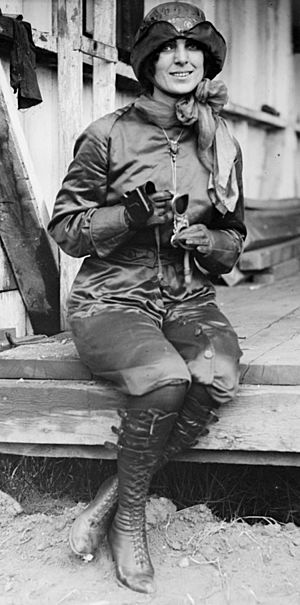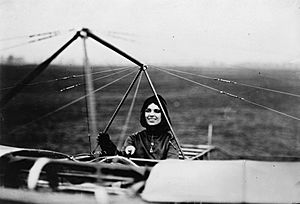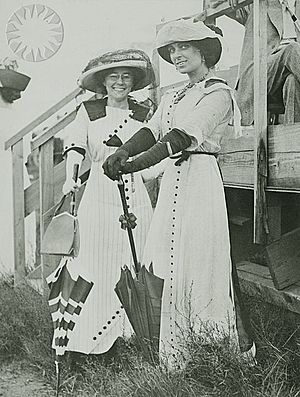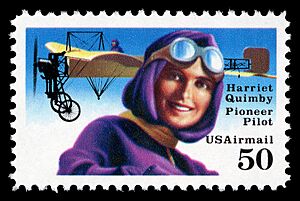Harriet Quimby facts for kids
Quick facts for kids
Harriet Quimby
|
|||||||||||
|---|---|---|---|---|---|---|---|---|---|---|---|

Quimby circa 1911
|
|||||||||||
| Born | May 11, 1875 |
||||||||||
| Died | July 1, 1912 (aged 37) Squantum, Massachusetts, USA
|
||||||||||
|
|||||||||||
Harriet Quimby (born May 11, 1875 – died July 1, 1912) was an amazing American pilot, writer, and movie script creator. She was a true pioneer in aviation.
In 1911, Harriet made history. She became the first woman in the United States to get a pilot's license. It was given to her by the Aero Club of America. Just one year later, in 1912, she achieved another incredible feat. She became the first woman ever to fly an airplane across the English Channel. Even though Harriet lived only to be 37 years old, her brave flights and adventurous spirit greatly inspired other women in aviation.
Contents
Early Life and First Jobs
Harriet Quimby was born on May 11, 1875, in Arcadia Township, Manistee County, Michigan. Her family bought a farm there in 1874. Later, around 1888, they moved to Arroyo Grande, California. In the early 1900s, her family moved again to San Francisco, California. There, Harriet started her career as a journalist.
Harriet's public life began in 1902. She started writing for the San Francisco Dramatic Review. She also wrote for the Sunday newspapers like the San Francisco Chronicle and the San Francisco Call. In 1903, she moved to Manhattan, New York City. She became a theater critic for Leslie's Illustrated Weekly. Over nine years, she published more than 250 articles there.
Harriet kept writing for Leslie's even when she was traveling for airshows. She wrote exciting stories about her flying adventures. She was very passionate about flying. Harriet actively promoted flying as a great sport for women. She also believed that airplanes could be used for business.
Harriet became interested in aviation in 1910. She went to an airshow called the Belmont Park International Aviation Tournament. It was held in Elmont, New York. There, she met John Moisant, a famous pilot and flight school owner. She also met his sister, Matilde Moisant.
On August 1, 1911, Harriet took her pilot's test. She passed and became the first woman in the U.S. to earn an Aero Club of America pilot's certificate. Her friend, Matilde Moisant, soon followed. Matilde became the second woman to get a pilot's license in the U.S.
Harriet Quimby's Aviation Career
After getting her pilot's license, Harriet became very famous. People called her the "Dresden China Aviatrix" or "China Doll." This was because she was small and had fair skin. Pilots at the time could earn a lot of money. They could get $1,000 for one show. Prize money for races could be $10,000 or more! Harriet joined the Moisant International Aviators. This was a team that put on flying shows. She made her first professional flight in Staten Island. She earned $1,500 for flying at night in front of almost 20,000 people.
Harriet was one of the few female pilots in the country. She used her unique style to stand out. She wore special plum-colored satin trousers tucked into high boots. She also wore a necklace and an old bracelet. Crowds loved to watch her fly in races and cross-country events. As part of the flying team, she showed off her skills all over the United States. She even went to Mexico City in late 1911. She flew there to celebrate the new President, Francisco I. Madero.
Harriet Quimby in Hollywood
In 1911, Harriet Quimby wrote seven movie scripts. These were made into short silent films by Biograph Studios. All seven films were directed by a famous filmmaker named D. W. Griffith. Some of the stars in her movies included Florence La Badie, Wilfred Lucas, and Blanche Sweet. Harriet even had a small acting role in one of her own movies!
Becoming a Spokesperson for Vin Fiz
The Vin Fiz Company was a part of the Armour Meat Packing Plant in Chicago. They hired Harriet Quimby to be the face of their new grape soda, Vin Fiz. This happened after another famous pilot, Calbraith Perry Rodgers, passed away in April 1912. Harriet's special purple flying uniform and her picture were used in many advertisements back then.
Flying Across the English Channel
On April 16, 1912, Harriet Quimby made history. She took off from Dover, England. Her goal was to fly to Calais, France. She completed the flight in just 59 minutes! She landed about 25 miles from Calais, on a beach in Équihen-Plage, Pas-de-Calais. This made her the first woman ever to pilot an airplane across the English Channel. However, her amazing achievement didn't get much attention in the news. This was because the huge Titanic ocean liner had sunk the day before. Everyone was focused on that tragic event.
Harriet Quimby's Death
On July 1, 1912, Harriet was flying in the Third Annual Boston Aviation Meet. This event was held in Squantum, Massachusetts. Harriet flew her brand-new two-seat Bleriot monoplane. William A. P. Willard, who organized the event, was a passenger with her.
When they were about 1,000 feet high, the plane suddenly tilted forward. No one knows exactly why this happened. Both Harriet and Mr. Willard were thrown from the plane. They sadly fell to their deaths. The plane then glided down and landed safely in the mud.
Harriet Quimby was first buried in the Woodlawn Cemetery in The Bronx, New York. The next year, her remains were moved to the Kensico Cemetery in Valhalla, New York. There is a special monument for Harriet Quimby in Burbank, California. It's called the Harriet Quimby Compass Rose Fountain. It's near the Portal of the Folded Wings, a place where ashes of aviation pioneers are kept. A plaque on the fountain says:
Harriet Quimby became the first licensed female pilot in America on August 1, 1911. On April 16, 1912, she was the first woman to fly a plane across the English Channel. She pointed the direction for future women pilots including her friend, Matilde Moisant, buried at the Portal of the Folded Wings.
Harriet Quimby's Legacy
Harriet Quimby's bravery and achievements are still remembered today. In 1991, the United States Postal Service made a special 50-cent airmail postage stamp featuring Harriet Quimby.
She is also honored with two official historical markers in Michigan. One is near Coldwater. The other is near the old farmhouse in Arcadia Township where she lived as a child.
In 2004, Harriet Quimby was added to the National Aviation Hall of Fame. This is a very special honor for people who have made big contributions to aviation.
In 2012, she was also inducted into the Long Island Air and Space Hall of Fame.
There is a road named after her, Quimby Road, at Reid–Hillview Airport in San Jose, California.
|
See also
 In Spanish: Harriet Quimby para niños
In Spanish: Harriet Quimby para niños





